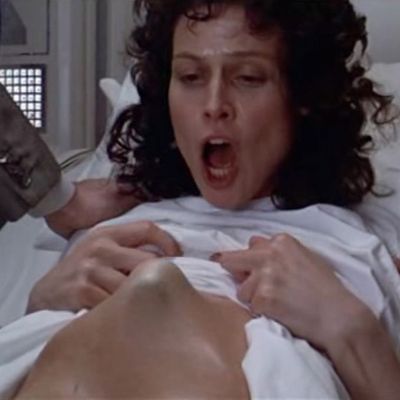
Bump is a classic nightmare term: a bump in the night. It’s ominous, sudden, unknown. And “baby bump” — that favorite tabloid term to describe the pregnant womb of a celebrity — does not sound like a smaller, cuter nightmare. A baby bump just sounds like a new, impending nightmare. Images of Rosemary’s Baby reel in the mind. The baby bump must be stopped.
I am not the first to object to this term. As other critics have astutely noted, it is disgusting, and represents yet another avenue for criticizing the female body. These are great points that should be echoed again and again until the term is scourged from our brains. But, I would argue, the biggest problem with “baby bump” is that it sounds like a topographical feature on the horror-scape of Satan’s hell.
Recent months have brought a fresh crop of public bumps: There is the nation’s baby bump (hosted by Chelsea Clinton), a sitcom-darling baby bump (currently carried by Mila Kunis’s womb), and a Hollywood-siren baby bump (aboard Ms. Scarlett Johansson). With each bump, I feel horrors anew. There it is, proclaimed in Easter-egg-colored text, usually alongside a photo of a pregnant starlet in an artfully draped gown, holding her midsection. It’s treated as a sunny little joke; it’s all exclamation points and breathless glee around baby bumps. Tabloids even go on bump watches. These only highlight the looming dread of the bump. They’re like a tornado watch or the last two-thirds of Jaws.
How and why did we become saddled with this deeply unsettling euphemism? Former Us Weekly editor Janice Min’s exhaustive coverage of celebrity mothers and their offspring made the usage of “baby bump” soar. (The bump, it should be noted, is extremely profitable. Min has said she is part of the multi-million-dollar “bump industry.”) Editor Bonnie Fuller first used the phrase in Us Weekly in 2002, though some tabloid experts associate it with U.K. papers. England is also the birthplace of gothic horror, just for a reference.
It’s true that earlier circumlocutions about pregnancy are laughably evasive and sentimental. A woman was in the family way or expecting a blessed event. At least “baby bump” acknowledges some physicality to the experience of pregnancy, noted Dvora Meyers in a Slate article on the etymology of the term. But the feminist critique of “baby bump” notes that it is still insidious. Meyers writes that the term “conveniently fuses our obsession with monitoring women’s sizes and appearances with our preoccupation with their reproductive functions.” And yet the baby bump is also weirdly separate from the woman’s own body. “Baby bump” evokes the pulsing monster in Sigourney Weaver’s Alien situation. It presents the protrusion as a supplementary growth: It’s baby as polyp, baby as tumor.
Dreadful swells and appalling protuberances are not the only baggage that the term carries, however; “baby bump” also denotes a mild violence. A bump is a light collision. There are bumper cars for make-believe vehicular mayhem. One accidentally bumps one’s head on a cabinet, perhaps when one is jittery while thinking about baby bumps. A yeti bumps into trees in the dark.
With all these associations — painful, grim, and spooky — the tabloid use of “baby bump” can perhaps be read as inadvertently hilarious and macabre. The bumps are hidden and debuted and revealed; premiered and Photoshopped and patted. And, perhaps most tellingly, baby bumps are something from which a celebrity must recover — very quickly, as even Janice Min lamented.
Just as one would wish to recover from a horrifying virus or an attack by a freaky gargoyle.




